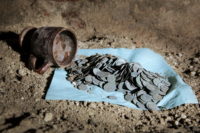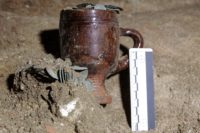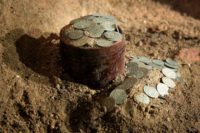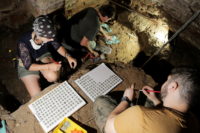 University of Gdansk archaeologists have discovered a hoard of nearly 1,000 coins under the church of St. Andrew the Apostle in Barczewo, northeastern Poland. The coins were found in and around a glazed ceramic mug buried under the north-western corner of the chancel. They date to the late 16th, early 17th century and are in good condition, albeit in need of cleaning.
University of Gdansk archaeologists have discovered a hoard of nearly 1,000 coins under the church of St. Andrew the Apostle in Barczewo, northeastern Poland. The coins were found in and around a glazed ceramic mug buried under the north-western corner of the chancel. They date to the late 16th, early 17th century and are in good condition, albeit in need of cleaning.
The coins are silver and were struck for the Polish royal crown and bear the image of King Sigismund III Vasa’s long reign (1587-1632).
The find is made up mainly of lower denomination Polish coins, and includes groschens, 1.5 groschens, as well as 3 and 6 groschen coins.
The haul includes many Prussian shillings struck for Prince George Wilhelm Hohenzollern, who was a fief of the Republic of Poland, as well as Lithuanian coins. […]
Many of the coins have marks on them suggesting that they were in circulation for a long time. One of them has a hole showing that it could have been worn around the neck.
 Starting out in the 14th century as settlement around a defensive castle belonging to the Bishop of Warmia, Barczewo, then known as Wartberg, was in the territory of Prussia after its conquest by the Teutonic Knights. Its Franciscan monastery was of central importance to the town politically and economically. Wartberg received city rights on July 4th, 1364, one of a dozen Warmian towns to receive city rights. It was the only one among them with an explicitly reserved square allocated to the monastery. St. Andrew the Apostle was built next to the monastery to serve as the monks’ church.
Starting out in the 14th century as settlement around a defensive castle belonging to the Bishop of Warmia, Barczewo, then known as Wartberg, was in the territory of Prussia after its conquest by the Teutonic Knights. Its Franciscan monastery was of central importance to the town politically and economically. Wartberg received city rights on July 4th, 1364, one of a dozen Warmian towns to receive city rights. It was the only one among them with an explicitly reserved square allocated to the monastery. St. Andrew the Apostle was built next to the monastery to serve as the monks’ church.
Barczewo became part of the Kingdom of Poland by the terms of the Second Peace of Thorn in 1466, but it was inside the boundaries of Royal Prussia, an autonomous area ruled by the Warmian bishops. Its autonomy waned when it joined the Polish-Lithuanian Commonwealth in 1569 and while it prospered in crafts and grew in size, it was also regularly beset by fires and military conflict. It burned twice in less than five years (1594, 1596) and was occupied by the Brandenburg Army in the mid-17th century.
 When the coins were buried, therefore, the monastery church was the safest place in town. After a period of abandonment during the Reformation in the first half of the 16th century, the monastery was restored by the Bishop of Warmia, the Bernardine order replacing the original Franciscans. The Warmian bishops supported the monastery generously for centuries. Archaeologists believe the coin hard was likely cached under the floor by the monks themselves for reasons unknown.
When the coins were buried, therefore, the monastery church was the safest place in town. After a period of abandonment during the Reformation in the first half of the 16th century, the monastery was restored by the Bishop of Warmia, the Bernardine order replacing the original Franciscans. The Warmian bishops supported the monastery generously for centuries. Archaeologists believe the coin hard was likely cached under the floor by the monks themselves for reasons unknown.
 The excavation is a rescue operation before construction work begins to strengthen the subsoil under the church’s foundation. The extensive restoration project for the church is expected to last through 2021. The coins will be conserved and then displayed in the church itself in a new exhibition space.
The excavation is a rescue operation before construction work begins to strengthen the subsoil under the church’s foundation. The extensive restoration project for the church is expected to last through 2021. The coins will be conserved and then displayed in the church itself in a new exhibition space.